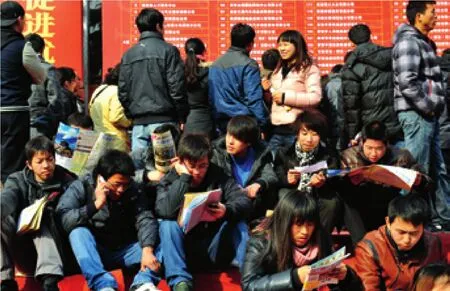Bolstering the Job Market
2012-10-14EmploymentgrowthbecomesthenationfocusByLanXinzhen
Employment growth becomes the nation’s focus By Lan Xinzhen
Bolstering the Job Market
Employment growth becomes the nation’s focus By Lan Xinzhen

ANXIOUS JOBSEEKERS: A large crowd wait at a job fair in Xi’an, capital of northwest China’s Shaanxi Province on February 11
Li Gaoping, a migrant worker from a village in north China’s Hebei Province, came to Beijing for a weekly job fair. This was Li’s second time on the hunt for a job after the Spring Festival, which fell on January 23 this year.
Li used to be an advertisement salesman in Beijing, earning about 3,000 yuan ($476)each month. In October 2011, he quit his job due to family issues in his hometown. After all his leads turned up dry, he returned to the capital.
The job fair Li attended was set up for unskilled laborers. Most job seekers there don’t have a bachelor’s degree. Each district of Beijing has a similar job fair,available for companies that have lower requirements for job hunters’ education background.
This time, about 100 companies were recruiting employees at the job fair, providing nearly 1,000 job vacancies. But only 200 people showed up. Li perused the requirements of each company, searching for any suitable information. But by the day’s end, Li left disappointedly.
In the current job market, a contradiction is making it increasingly difficult for companies and job seekers to fi nd a common ground: Companies don’t have enough employees and job seekers can’t find suitable jobs.
The problem isn’t that China lacks job vacancies or a labor force. But “labor shortage”and “employment dif fi culty” coexist.
Li said he could not accept wages that won’t allow him to maintain a decent living.Generally, employers only give 1,000 yuan($158.8) to 2,500 yuan ($397) each month to job seekers like Li.
“In a big city like Beijing, you can hardly feed yourself with 2,500 yuan ($397) a month,” said Li.
The problem is being addressed in the Employment Promotion Plan (2011-15) recently issued by the State Council on February 7. The plan says the country will reform its income distribution mechanism. During the 12th Five-Year Plan period (2011-15), the minimum wage will be increased by at least 13 percent annually and the minimum wage in most regions should reach at least 40 percent of local urban employees’ average wage.
The plan, jointly initiated by several key government departments, is the fi rst national plan for promoting employment.
“In the future, promoting employment will be a top priority for China’s social and economic development,” said Yu Faming,Director of the Department of Employment Promotion of the Ministry of Human Resources and Social Security.
“China is a developing country with the biggest population and the largest group of laborers in the world. Giving employment promotion top priority is in accordance with the real conditions in the country,” Yu said.
Key indexes, such as the increased urban employment and registered urban unemployment rate, will be added to the evaluation of local governments. Giving employment promotion a top priority, as is stipulated in the plan, is a compulsory task for local governments, he said.
Contradictions
But Li thinks the 13-percent annual wage hike stipulated in the plan may be a dream beyond reaching. Wages depend on companies’ performance that is in fl uenced by a number of factors.
Price hikes of raw materials, global economic recession, and the yuan’s appreciation all contribute to fewer economic gains among Chinese enterprises. Some can hardly survive,not to mention giving employees salary boosts.
This may be the reason why they can’t promise higher wages to job seekers. During the past two years, China’s minimum wages increased sharply, especially in some east coastal cities where workers’ annual average income increased 10-15 percent. But due to the previous low wages and soaring CPI,China’s minimum wages are still less than countries or regions at the same development level.
A bigger contradiction in the job market results from the integration of migrant workers into cities. Migrant workers account for the biggest part of demand in China’s labor market, but they are discriminated in social security because they lackhukou, or permanent household registration, in cities they work in.
The plan also pledges to accelerate economic development of townships and counties, providing surplus rural laborers with more job opportunities nearby their hometowns. The key lies in equal employment between urban and rural laborers and the improvement of an employment mechanism for migrant workers.
Difficulties
Numerous job seekers have caused some newspapers and media outlets to exaggerate China’s job market crisis.
“China’s employment situation is not as bad as imagined,” said Li Chang’an, associate professor of School of Public Administration of University of International Business and Economics.
“China’s urban registered unemployment rate has been kept below 5 percent and the total number of registered unemployed people is around 10 million. If calculated by international standards, China’s unemployment rate may be around 7-8 percent, similar to the current situation in the United States,” said Li
According to him, China’s unemployment issue has several distinctive characteristics,among which the most serious one is the structural unemployment. Due to the hukou policy, unemployment in urban and rural areas is given vastly different attention. Urban residents often benefit from favorable local policies, but most floating rural populations are not included in unemployment registration.
The second is the unemployment among youths. Today, nearly 2 million college graduates, 30 percent of the total, will have dif fi culty in fi nding jobs after graduating.
Also, low employment quality, unstable positions, frequent job-hopping, low wages and poor working environment make China’s labor market very fragile.
“These are the main dif fi culties for China to solve its unemployment problem,” said Li.
The service industry is widely recognized as the most effective sector to absorb employees. But since the reform and opening up in 1978, the development speed of the service sector falls behind manufacturing in most years. The lagging of the service industry is a major obstacle for employment promotion.
More importantly, although small and medium-sized private enterprises create over 75 percent jobs, their development problems are a big restraint for creating jobs. Poor management and abrupt closures of private enterprises are the main cause for large-scale unemployment, or even conflicts between both sides.
The employment situation will be more complicated as the number of job seekers increases. Each year, 25 million urban residents need jobs and a considerable number of rural surplus laborers need to be transferred from rural areas, according to the Ministry of Human Resources and Social Security.
Along with technology improvement and upgrades in industries, the shortage of skilled laborers will be more serious, said the ministry in a statement.
Solutions
“China is a country with surplus of laborers,making promoting employment a key target for the Central Government,” said Li. “When formulating macroeconomic plans, the government should choose a development pattern that’s beneficial for promoting employment and form a long-term mechanism with interaction of economic development, adjustment of the industrial structure and employment promotion.”
China is adjusting its industrial structure via upgrading technology, which will make it more difficult for unskilled migrant workers to fi nd jobs.
“Right now, labor-intensive industry has strategic significance,” said Li. The government should give more support to the service industry and avoid favoring on heavy and chemical industries, although they are an inevitable link for industrialization and modernization.
Currently, heavy and chemical industries have absorbed over 80 percent of the total investment, but have only provided 25 percent of employment.
Increasing investments in the service industry can play a big role in employment promotion, Li said.
